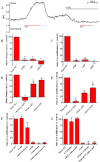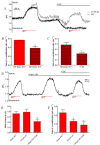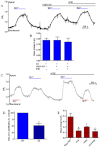Protein phosphatase 1 coordinates CFTR-dependent airway epithelial HCO3- secretion by reciprocal regulation of apical and basolateral membrane Cl(-)-HCO3- exchangers
- PMID: 23215877
- PMCID: PMC3623064
- DOI: 10.1111/bph.12085
Protein phosphatase 1 coordinates CFTR-dependent airway epithelial HCO3- secretion by reciprocal regulation of apical and basolateral membrane Cl(-)-HCO3- exchangers
Abstract
Background and purpose: Our recent studies on human airway serous-like Calu-3 cells showed that cAMP agonists stimulated a HCO3(-) rich secretion containing up to 80 mM HCO3(-). This alkaline secretion relied on a coordinated switch in the activity of distinct Cl(-)-HCO3(-) anion exchangers (AE) located at different regions of the cell. At the apical membrane, cAMP agonists activated the electroneutral AE pendrin (SLC26A4), together with cystic fibrosis transmembrane conductance regulator (CFTR), while at the basolateral membrane the agonists inhibited AE2 (SLC4A2). However, the underlying mechanism(s) that orchestrates this cAMP-dependent switch in AE activity has not been elucidated.
Experimental approach: Apical and basolateral Cl(-)-HCO3(-) exchange was assessed by measuring Cl(-)-dependent changes in intracellular pH (pH(i)).
Key results: We show that protein phosphatase 1 (PP1), together with CFTR, play central roles in this reciprocal regulation of AE activity. Activation of pendrin by cAMP agonists, but not inhibition of the basolateral exchanger, was protein kinase A-dependent. Knocking down CFTR expression, or blocking its activity with GlyH-101, led to incomplete inhibition of the basolateral AE by cAMP, supporting a role for CFTR in this process. Addition of the PP1/2A inhibitor, okadaic acid, but not the PP2A specific inhibitor fostreicin, mimicked the effect of cAMP stimulation. Furthermore, okadaic acid-treated Calu-3 monolayers produced a more alkaline fluid than untreated cells, which was comparable with that produced by cAMP stimulation.
Conclusions and implications: These results identify PP1 as a novel regulator of AE activity which, in concert with CFTR, coordinates events at both apical and basolateral membranes, crucial for efficient HCO3(-) secretion from Calu-3 cells.
© 2012 The Authors. British Journal of Pharmacology © 2012 The British Pharmacological Society.
Figures










Similar articles
-
Novel role for pendrin in orchestrating bicarbonate secretion in cystic fibrosis transmembrane conductance regulator (CFTR)-expressing airway serous cells.J Biol Chem. 2011 Nov 25;286(47):41069-82. doi: 10.1074/jbc.M111.266734. Epub 2011 Sep 13. J Biol Chem. 2011. PMID: 21914796 Free PMC article.
-
Role of anion exchangers in Cl- and HCO3- secretion by the human airway epithelial cell line Calu-3.Am J Physiol Cell Physiol. 2014 Jul 15;307(2):C208-19. doi: 10.1152/ajpcell.00083.2014. Epub 2014 Jun 4. Am J Physiol Cell Physiol. 2014. PMID: 24898583
-
Basolateral chloride loading by the anion exchanger type 2: role in fluid secretion by the human airway epithelial cell line Calu-3.J Physiol. 2012 Nov 1;590(21):5299-316. doi: 10.1113/jphysiol.2012.236919. Epub 2012 Jul 16. J Physiol. 2012. PMID: 22802585 Free PMC article.
-
Airway Surface Liquid pH Regulation in Airway Epithelium Current Understandings and Gaps in Knowledge.Int J Mol Sci. 2021 Mar 25;22(7):3384. doi: 10.3390/ijms22073384. Int J Mol Sci. 2021. PMID: 33806154 Free PMC article. Review.
-
The molecular mechanism of CFTR- and secretin-dependent renal bicarbonate excretion.J Physiol. 2021 Jun;599(12):3003-3011. doi: 10.1113/JP281285. Epub 2021 May 29. J Physiol. 2021. PMID: 33963548 Review.
Cited by
-
Epithelial anion transporter pendrin contributes to inflammatory lung pathology in mouse models of Bordetella pertussis infection.Infect Immun. 2014 Oct;82(10):4212-21. doi: 10.1128/IAI.02222-14. Epub 2014 Jul 28. Infect Immun. 2014. PMID: 25069981 Free PMC article.
-
Airway surface liquid acidification initiates host defense abnormalities in Cystic Fibrosis.Sci Rep. 2019 Apr 24;9(1):6516. doi: 10.1038/s41598-019-42751-4. Sci Rep. 2019. PMID: 31019198 Free PMC article.
-
Mechanism and synergism in epithelial fluid and electrolyte secretion.Pflugers Arch. 2014 Aug;466(8):1487-99. doi: 10.1007/s00424-013-1390-1. Epub 2013 Nov 16. Pflugers Arch. 2014. PMID: 24240699 Free PMC article. Review.
-
The CFTR trafficking mutation F508del inhibits the constitutive activity of SLC26A9.Am J Physiol Lung Cell Mol Physiol. 2017 Jun 1;312(6):L912-L925. doi: 10.1152/ajplung.00178.2016. Epub 2017 Mar 30. Am J Physiol Lung Cell Mol Physiol. 2017. PMID: 28360110 Free PMC article.
-
Pendrin, an anion exchanger on lung epithelial cells, could be a novel target for lipopolysaccharide-induced acute lung injury mice.Am J Transl Res. 2016 Feb 15;8(2):981-92. eCollection 2016. Am J Transl Res. 2016. PMID: 27158384 Free PMC article.
References
-
- Al-Bazzaz FJ, Hafez N, Tyagi S, Gailey CA, Toofanfard M, Alrefai WA, et al. Detection of Cl-HCO3- and Na+-H+ exchangers in human airways epithelium. JOP. 2001;2:285–290. - PubMed
Publication types
MeSH terms
Substances
Grants and funding
LinkOut - more resources
Full Text Sources
Other Literature Sources

